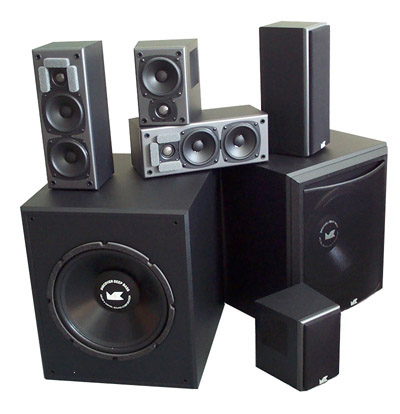Product Review - M&K K-7 and K-4 (Surround) Loudspeakers with V-75 Mk II Subwoofer - April, 2002 Brian Florian
|
|
|
Specifications:
K-7
"Main" Speaker K-4
Surround Speaker
V-75
Mk II Subwoofer
|
| M&K Sound Corporation, 9351 Deering Avenue, Chatsworth, California 91311 USA; Web http://www.mksound.com; Phone 818-701-7010; Fax 818-701-0369 |
Introduction (or "The Emperors New Speakers")
The fable of "The Emperors New Clothes" is well known to most. The amusing tale relates the activities of a couple of scam artists who convince the emperor they can make him some new gear which will really be the cream. They don't actually do anything with the spinning wheel though, telling the emperor that they've got a new way of spinning thread which makes it so refined, only those worthy of it can see it and appreciate it. When it comes time to actually weave the fabric, the same excuse is given for the loom being empty. I'll save us the tedium and simply conclude for those not familiar with the tale that the emperor buys into everything the charlatans tell him, and he ends up cruising the town naked, showing off his "new" clothes which nobody wants to admit they can't see.
Unfortunately, the hi-fi world gets away with a little bit of the marketing strategy the emperor's tailors used to sell him thin air. No one is actually trying to sell an empty box as a speaker but more often than not we as consumers are talked into a heighten perceived value by tales of precision machined such and such, solid aluminum this and that, components made from titanium, neodynium, or polyglass, all put together with "special" polyurethane adhesives and topped off with goodies like "unique" port designs and wave guides.
There is nothing wrong with any of the above, nor is there anything wrong with touting it in product literature as long as we keep in perspective just how much is really contributing to performance, in what area, and above all to what degree.
M&K is a refreshing change from the ordinary in this regard, being selective in what they list as features in their products. You can read the brochure specs, but it's a pretty dry lecture compared to most. They like to talk more about performance goals and how they are achieved through design. Naturally a speaker needs to be made from "good parts", but its presence is no guarantee of anything. It costs just as much to get it right as it does to get it wrong. Perhaps it is because M&K is big in the Pro Market, and BS is just a waste of ink.
Of Satellites and Subwoofers . . .
M&K knows a thing or two about satellite speakers and subwoofers, the very icons of home theater audio. What's ironic is the time line. In the early 70s Ken Kriesel was involved in recording and was working with a lot of pipe organ material which prompted him to look into subwoofer design. In 1973, Ken was asked to design a speaker system for the studio recording of Pretzel Logic and produced a system which included a subwoofer. As is so many times the case with such things, everyone wanted one of the subs. In 1974 Ken and business partner Jonas Miller founded M&K with the first product line consisting of high-performance subwoofers and direct-to-disc LPs. Keep in mind this is 5 years before Dolby Stereo comes to movie theaters (1979) and nearly a decade before it comes to home theater. In 1976, with the involvement of Dr. Lester Field, M&K produced its first satellite speaker, setting the precedent. With but a couple exceptions, all of their designs are fundamentally sat/sub combinations. In 1977 M&K produced the Satellite-1, a speaker with a unique design goal: controlled vertical dispersion, something which nearly two decades later would be a mandate under THX's home theater speaker program.
M&K's basic design goals for satellite speakers and subwoofers remains, as always, a noble assembly of values: Low Distortion, Flat Frequency Response (across a wide window), decent Transient Response, and healthy Dynamic Range.
Consider for a moment M&K speaker systems, which in their day were regarded as premier music speakers, embodying the same design principals which we now recognize as being the cornerstones of home theater speakers. M&K did not jump on the home theater bandwagon: They are one of horses who continue to pull it!
Anyone following the M&K product line over the last several years would probably say they are working their way down from what can only be described as reference caliber speakers to more real world and affordable designs. It is unfortunate that the consumer's natural instinct is to regard a lower priced product as inferior. With M&K, smaller, less expensive models like the tiny Xenon speakers or these K Series wonders do give up something, but it is more a sacrifice of raw output/headroom, and less a sacrifice of sonic integrity. Put another way, the smaller, less expensive M&K speakers are simply much of the same good stuff, only for smaller rooms.
Back to Basics
A tweeter and two mid/bass drivers in a sealed box. That's it. No funky whatchamagijets. The cones are 4" polypropylene, and the tweeter is a 1" soft dome with a neodymium magnet. Neodymium is often mis-represented in speaker brochures as being the end-all-be-all, when in reality the "feature" is that it lets a driver manufacturer get away with a physically smaller magnet, practically a prerequisite for an enclosure as small so those across the K Series. Sensible binding posts are positioned high on the back, and wall mounting hardware is provided. The build and finish is impeccable. The only thing really out of the ordinary (compared to other brands, not for M&K) on these speakers are the foam pads surrounding the tweeter.
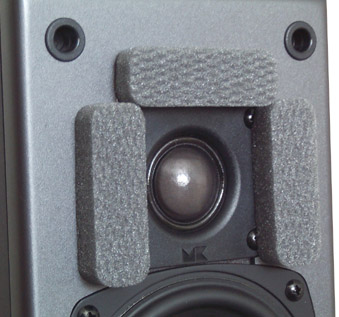 The front baffle foam, in concert with
the Phased Focused crossover we'll look at next, is used to improve the speaker's off-axis frequency response.
M&K also tells us the foam improves the on-axis response, and as an additional benefit, reduces diffraction,
though it is not the main reason for it. This particular foam was
apparently selected after evaluating over 100 combinations of materials.
The point here is that the pads are part of the holistic design and not a
"tweak".
The front baffle foam, in concert with
the Phased Focused crossover we'll look at next, is used to improve the speaker's off-axis frequency response.
M&K also tells us the foam improves the on-axis response, and as an additional benefit, reduces diffraction,
though it is not the main reason for it. This particular foam was
apparently selected after evaluating over 100 combinations of materials.
The point here is that the pads are part of the holistic design and not a
"tweak".
At around 2.5 kHz, the tweeter hands over to the two mid/bass drivers through an implementation of M&K's Phase Focused crossover. Phase Focused is M&Ks cool and trademarked way of saying that they spend lots and lots of time designing the crossover to get it right. Specifically, the crossover and the drivers are taken as a whole, and the desired response is achieved across the horizontal and vertical axis, not just square in front of the speaker. High quality drivers are a requisite for a good speaker, but they don't mean jack unless they've been properly implemented.
Being a sealed enclosure, the two mid/bass drivers gracefully begin their roll off around 80 Hz in a 2nd order slope a-la THX. Coincidence? I think not. Besides making them the perfect fit for the ubiquitous THX crossover, the sealed alignment affords the small drivers a generous amount of protection. With the X-over set at 80 Hz, what might have been abusive signal levels for lesser designs were chewed up and spit out by these little marvels.
Finally: A "Real" Center Speaker
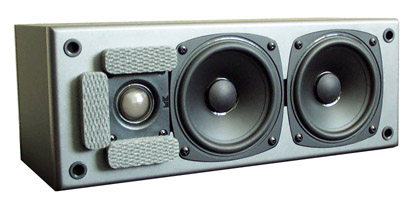 Consider for a moment the ubiquitous horizontal
D'Appolito driver arrangement
which persists
on so-called center channel speakers. There are dozens of reasons why it's a bad
design choice, and some manufacturers have told us they use it because "it
looks symmetrical". Once, while at CES, Colin Miller and I asked one manufacturer at
the show what steps they had taken to alleviate the common problems of the
horizontal mid-tweet-mid layout of their speaker (the most noteworthy being lobbing/comb
filtering off center), and the guy actually said to us, "If its that big a
deal to you, just stand it on end".
Consider for a moment the ubiquitous horizontal
D'Appolito driver arrangement
which persists
on so-called center channel speakers. There are dozens of reasons why it's a bad
design choice, and some manufacturers have told us they use it because "it
looks symmetrical". Once, while at CES, Colin Miller and I asked one manufacturer at
the show what steps they had taken to alleviate the common problems of the
horizontal mid-tweet-mid layout of their speaker (the most noteworthy being lobbing/comb
filtering off center), and the guy actually said to us, "If its that big a
deal to you, just stand it on end".
Before everyone with a mid-tweet-mid center speaker goes home feeling bad, I should say that although rare, they can be made to work within a reasonable horizontal listening window. When we asked Paradigm about their Studio/CC speaker, not only did they know what we were talking about, but they actually had some explanations for how they addressed the design challenge, such as using a very robust tweeter which can be crossed over unusually low (and the lower you cross over, the farther off axis you'll have to be before combing becomes serious).
An M&K K-7 speaker on its side (with the logo appropriately repositioned) is all it takes to make a real center speaker which cares not for the non-symmetrical appearance of its drivers. Because the speakers were designed from square one for even response across both the horizontal and vertical axis, a K-7 lying down is no different sonically from one standing on end. After all, front left/right speakers often have their drivers asymmetrical, so why is symmetry so important with the center? Must be all those brochures.
What's that? Even dispersion both horizontally and vertically? Yes. Consider that when THX issued their Select specification for speakers, besides simply lowering the required output, they also dropped the need for speakers to be vertically directional, the rationalization being that in smaller rooms the speakers are closer to us, and in consequence, we receive much more direct sound, making ceiling reflections less of an issue. The K Series follow suit from M&K's THX Select set, giving us a very versatile speaker, less sensitive to positioning.
 So
Simple, It Actually Works
So
Simple, It Actually Works
Most home theater enthusiasts have been on the Internet forums and seen the arguments . . . I mean . . . the debates over surround speakers: Dipoles or Direct Radiators. Can't we all just get along? Can't we just make a speaker that is both? Wait! M&K has already done that.
The K-4 is only one of the more recent M&K speakers employing their tri-pole configuration, and on the surface it is as simple as it sounds: A dipole and a direct radiator in one box. We have a tweeter and woofer (same drivers as the K-7) on the front, and on each side, a 4" full range driver, the pair being out of phase with each other. In practice, I hate to think of the design challenge in getting a nice even response across the entire hemisphere of radiation, but M&K has done it. Again M&K credits their Phased Focused Crossover design approach for this achievement. The dipole component does not actually reach quite as far across the frequency spectrum, having a natural roll off at the extreme highs and purposely is rolled off at 300 Hz, below which the front mid bass driver handles all the bass. The Tripole therefore is in essence a conventional speaker with a "fill" component to its sound.
So Confident, They Silk Screen It On the Driver
You can't mistake an M&K subwoofer driver: Their white logo, silk screened to the dust cap, is somewhat a bawdy bit of marketing (it does look really cool). In addition to the logo though one can plainly read the statement: "Discover Deep Bass". To paraphrase the many permutations of dictionary definitions, the word discover means "To notice or learn about for the first time in one's experience, especially by making an effort". The implication of the logo/phrase therefore is that if you have not heard M&K bass, you have not heard "deep bass". A bold statement to be sure, but not without substance.
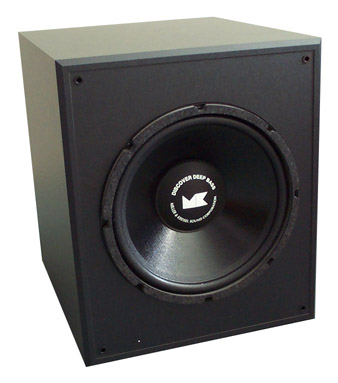 The V-75 is on the small side, as far as
subwoofers go. In the broad strokes, it is a single 12"
driver in a sealed box with a gain knob, variable low pass adjustment, and
phase switch. Line level and speaker level inputs are of course provided
along with the usual auto on/off convenience. Long have
people lamented the lack of a benchmark for subwoofer amplifier specs, and
M&K, perhaps to their marketing departments lamenting, is more honest and
conservative than most. "75 watts" does not impress. Yet when you
consider that their entry level THX Ultra sub is quoted at 150 watts, you start
to put it into perspective. Even if this particular model's amp is on
the modest side, you'd be hard pressed to know it. As with all M&K
amps, the V-75 has the "Headroom Maximizing Circuit" which curbs only the portion of the signal which is out of the
system's range, as oppose to compressing the entire signal.
The V-75 is on the small side, as far as
subwoofers go. In the broad strokes, it is a single 12"
driver in a sealed box with a gain knob, variable low pass adjustment, and
phase switch. Line level and speaker level inputs are of course provided
along with the usual auto on/off convenience. Long have
people lamented the lack of a benchmark for subwoofer amplifier specs, and
M&K, perhaps to their marketing departments lamenting, is more honest and
conservative than most. "75 watts" does not impress. Yet when you
consider that their entry level THX Ultra sub is quoted at 150 watts, you start
to put it into perspective. Even if this particular model's amp is on
the modest side, you'd be hard pressed to know it. As with all M&K
amps, the V-75 has the "Headroom Maximizing Circuit" which curbs only the portion of the signal which is out of the
system's range, as oppose to compressing the entire signal.
While I'm sure M&K would love me to make a blanket statement that their subwoofers are the only ones in the world worth having, I will go so far as to say that other models which I have found to be the equal of M&K's conspicuously share one design element: They are all sealed speaker systems as oppose to ported (or those employing passive radiators). For a refresher on what exactly a bass reflex design offers, and at what cost, you can check out Colin Miller's excellent article on the subject. Done right, porting a speaker can pay generous dividends. All things being equal, you can reach down a third of an octave lower with a port but when you do, your response then drops off a virtual cliff. For a stand alone speaker, this is almost always a welcome trade-off as evidenced by the proliferation of ported designs. In the case of a subwoofer though, the trade-off becomes much less black and white. I don't want to make a conclusive technical statement here, but as a loose generalization, while sealed subs begin their roll off higher, they maintain output deep, deep down. Done right, room gain can just make up for the roll off and the sub/room combination can sum a nice flat response down to 20 Hz.
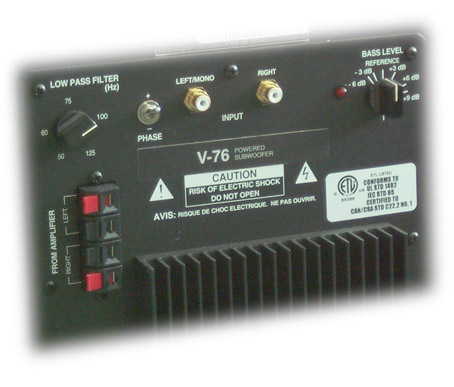 At Colin's urging, I asked M&K for
not one but two V-75 subwoofers. If a room has one "good"
corner for a subwoofer, the consensus is to stack multiple subs in that
corner, or if there is more foresight available, just get one good sub.
It's no secret that for the same price as this pair, a consumer could get one
of M&K's 150 mk II THX Ultra subwoofers and arguably have a better
bass system. JJ has an M&K MX-5000THX that he
chained to his wall because we constantly ask him if we can have it. But sometimes all the money isn't there at once and an
incremental system assembly is advantageous. More interestingly, what if
the room does not have one such "perfect subwoofer corner"? In
such situations a pair of subs can be advantageous, big time.
At Colin's urging, I asked M&K for
not one but two V-75 subwoofers. If a room has one "good"
corner for a subwoofer, the consensus is to stack multiple subs in that
corner, or if there is more foresight available, just get one good sub.
It's no secret that for the same price as this pair, a consumer could get one
of M&K's 150 mk II THX Ultra subwoofers and arguably have a better
bass system. JJ has an M&K MX-5000THX that he
chained to his wall because we constantly ask him if we can have it. But sometimes all the money isn't there at once and an
incremental system assembly is advantageous. More interestingly, what if
the room does not have one such "perfect subwoofer corner"? In
such situations a pair of subs can be advantageous, big time.
My current room, as evidenced by extensive experimentation and measurements, has two half decent positions for subwoofers: the front right corner and the rear right corner. The rear yields the highest SPL (room gain), but is somewhat less than flat, and subs tend to stick out sonically when placed there. The front position, while costing about 6 dB in efficiency, is much flatter. With one V-75 in each spot, and a little tweaking of the rear unit's level and low pass, I achieved virtually perfect in-room response.
And The Sound? Let me just come out and say it.
This setup, with the solitary and simple qualification of room size, is the best I have ever heard in, around, and even quite a bit above the price point. Period. Nothing, and I mean nothing, sounded wrong. Everything I threw at the system sounded freaking awesome.
This lends me to deduce that the K-7s, K-4s, and the subwoofers are as neutral as can be conceived. Want some nitty gritty specifics?
Treble is detailed without being harsh, resonant, or bright. It is comfortable without being laid back or reserved. The K7s image like crazy. Voices and instruments are natural, natural, natural! Amanda Marshall's aggressive vocals are as smooth as silk. Yo Yo Ma, experimenting with Bach, was a somewhat religious experience sonically. There are no aberrations as I shift the seating position horizontally, nor are there any as I raise the volume to irresponsible levels. "Reference Level Playback"? You bet, and without the discomfort which in other speakers had caused me to almost give up hope on the whole ref level concept. This made me curious: The SPL levels are the same, so why did these speakers not sound too loud like so many others? I've got a few juicy ideas . . . .
First, their drivers are designed to honestly handle a lot of power. M&K also seems to put a lot of focus in designing for low distortion at high levels, so at those levels you won't get harmonic energy tilting up the spectrum balance to make the sound more shrill than at quieter levels. Another thing is that they use air-core inductors, but you don't see them flaunting that in the product brochures. The Pro Market assumes it, and expects it.
I could not go so far as to say that M&K is the only company that can pull this off. Yet, the comments I'm making on these entry level speakers of theirs are coincident with the sort of comments that have been made by respected press entities in the past on their more upscale and pro-model speakers, lending credence to the sentiment that their design goals are consistently met over and over, regardless of "entry level" or "reference."
As for the tripoles, they just plain work. Instead of the traditional dipole location, to my immediate left and right, I instead put them high up in the back corners pointing 450 into the room. This made for an absolutely delicious combination of directional and diffuse sound. The 5.1 of Sting's "Brand New Day" makes somewhat zealous use of the surrounds, and the desired effect (like it or not) was successfully rendered by the K-4s. Yet in the same breath, the subtle environmental cues of the "Das Boot" 5.1 remaster were enveloping, not calling attention to themselves as is usually the case with a monopole speaker.
As for the subwoofers: they were tight, smooth, latent, and clear. Whatever arbitrary adjective you recognize as positive. Reference level playback of even the new ("Rain") THX logo trailer did not tax the subs, the deep sweeps being voiced with aplomb. Pushing them beyond the practical, the very walls of the house had to be vibrating before the pair voiced any notable distortion, and at that point, it was difficult to distinguish between the resonance from the walls and any deficiencies in the sub's output. Honestly, the pair might have been overkill for the size of room but man were they flat together! [Editor's Note: There is no such thing as overkill with subwoofers.] The V-75 pair achieved, by an appreciable gap, the flattest in-room response of any subwoofer system I have had the privilege of auditioning. It scares me to think what a pair of the company's MK-150 subs would do for a larger room.
I want to get on the soap box for just a second and remind everybody: you cannot "hear" 20 Hz! If you can, that's distortion your hearing, not an honest note. The low 20s are a sensation, not a sound. Unfortunately many have lost touch with this simple truth and routinely pass over a subwoofer as good as the M&Ks because the next one in the show room sounds louder, be it from port noise, internal resonance, or simply a driver smacking it limits. Do not be fooled. Check the SPL meter. The V-75s, corner loaded, are doing 20 Hz, and they are doing it cleanly. On the 5.1 soundtrack from "The Professional", there is a re-occurring, throbbing concussion used to invoke tension which, under ideal conditions, is felt, not heard. Try it sometime.
Conclusion
This is it. This is the speaker set to beat for small (~1500 ft3) rooms at this price. I, like M&K, will spare you any more colorful adjectives and amusing turns of phrase and simply tell you to find an M&K dealer within reasonable driving distance and get to know real hi-fi sound and true deep bass. Now!
- Brian Florian -
Equipment used for comparison and reference:
Paradigm Reference Studio/40 and Studio/CC speakers
Paradigm Mini-Monitor speakers
Velodyne CT-150 powered subwoofer
Smart Theater Systems 2X150VT amplifier
Rotel RB-985 5 channel THX amplifier
Yamaha RX-V795a processor/receiver
Toshiba 2108 DVD player
Yamaha CDC-695 CD player
Nordost Blue Heaven, Moonglow, and S-Optix cable
Sony KV-27S36 Trinitron TV
Smart Theater Systems GC120 AC Line Purifier
![]()
� Copyright 2002 Secrets of Home Theater & High Fidelity
Return to Table of Contents for this Issue.

